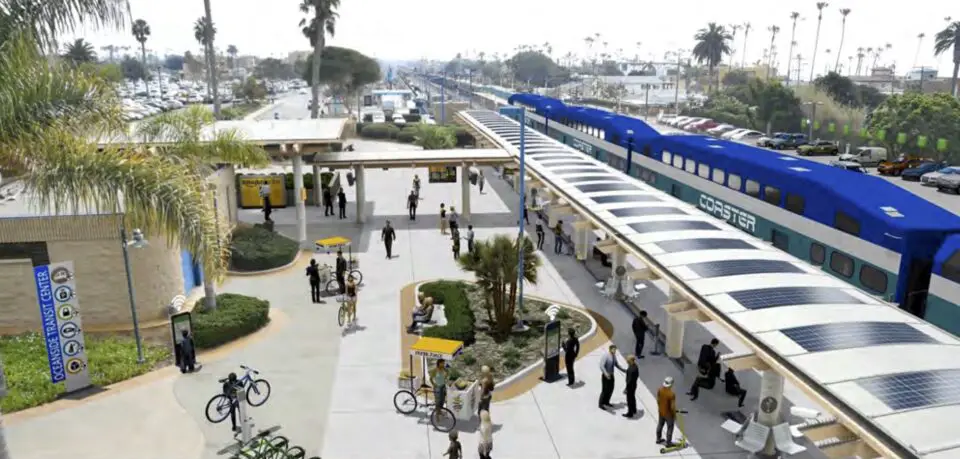REGION — Regional transportation planners estimated last week that their vision for a high-tech interconnected transit network could cost $177 billion over 30 years, a more than one-third increase over its current $128 billion plan.
Supervisor Jim Desmond, who represents District 5, which covers most of North County, warns that the $177 billion price tag, given in 2020 dollars, could balloon with inflation by the time capital projects actually break ground. He recently estimated as much as $440 billion, 3% inflation through 2050, although no specific project schedule yet exists and every project likely wouldn’t occur as late as 2050.
San Diego Association of Governments (SANDAG) staff presented their cost estimate at an Aug. 7 joint meeting of SANDAG’s transportation, regional planning and borders committees. The cost estimate will come before SANDAG’s full board of directors at their Aug. 14 meeting.
To the extent the board wishes to realize the staff’s vision in their official regional transportation plan update this fall, it’ll have to determine specifically how to pay for it.
SANDAG, or the San Diego Association of Governments, is the county’s metropolitan planning organization, a federally mandated body that oversees regional transportation planning and serves as a kind of gatekeeper for federal transportation dollars.

“This vision is not about [specific] projects … [or] money,” SANDAG Executive Director Hasan Ikhrata told committee members Aug. 7. “Those discussions will be done once we finalize the [regional transportation] plan and the projects. This vision is the foundation for all of that.”
Over the past year or so, SANDAG has shaped this vision, dubbed the “Five Big Moves,” from what staffer Antoinette Meier called “high-level concepts” into increasingly specific proposals. These would require new and expanded ways of using existing infrastructure, as well as new infrastructure and lots of technology.
The Five Big Moves include: (1) “complete corridors” (a highway network with “managed lanes” to maximize capacity and reduce congestion); (2) “transit leap” (a network of high-speed, high-frequency public transit options, include 120-mph trains); (3) “mobility hubs” (centralized areas where various transportation modes intersect and travelers could make easy connections); (4) “flexible fleets” (a broad portfolio of “shared mobility services,” such as Uber/Lyft, bike-share and scooter-share, to reduce reliance on cars); and (5) “the next operating system” (a one-stop-shop digital platform for users to blend various transportation options, as well as a means for “smart infrastructure” to adjust to real-time conditions).
Among other goals, these moves seek to take “a network perspective and to start to identify a broad set of improvements [for the region-as-a-whole], as opposed to isolated projects focused on a single bottleneck,” Meier said.
Ultimately the board must finalize a plan that’s based on “reasonably available funding between now and 2050,” Ikhrata said. “As to the cost and how we’re going to pay for it, I think that’s something for the board to debate. … This will be a combination of federal, state and local funding.”
“Our estimate is, we would get $2.44 [in state and federal money] … for every dollar that we spend locally,” based on historic trends, he said.
Several committee members, including elected officials from across the county, voiced approval of the vision last Friday, though others were more measured.
Desmond stood out as a skeptic, calling the vision “very San Diego [centric].”
“Bicycles and Vespas, and those types of things, are not going to work in North County as well as they would in downtown San Diego,” he said. “[A] regional plan should include roads for North County.”
“We’re not getting what was promised the last time,” he said, referring to 2004 plans to invest in North and East County roads, namely, state routes 78, 52, 67 and 94. “I would love to see your vision realized. But … asking the people for more money — again — without delivering on past promises is … something I’m not going to be able to support.”
The Five Big Moves vision does focus heavily on the southern part of the county, especially big employment centers in San Diego; the San Diego International Airport (serving as a kind of grand central station — a regional hub-of-hubs); and border areas, through which flows plenty of travelers, commuters and commerce.
But SANDAG staff said North County would realize benefits.
Together with Escondido, El Cajon and the border, Oceanside would serve as one of four “gateway hubs,” or “key entry points into the Five Big Moves network,” SANDAG staffer Marisa Mangan said. The Oceanside Transportation Center and the surrounding downtown would become a “vital mobility hub in North County.”
An improved multimodal transportation network would also help commuters get to Camp Pendleton and visitors to North County’s beach cities.
In addition to specifying revenue sources, honing the Five Big Moves vision into a solid plan would require more integration with local land use planning.
“Mobility hubs work best when you have a high concentration of people, destinations and travel choices,” Mangan said.
“The way we solve our housing crisis is looking at all the opportunities for housing in our mobility hubs,” SANDAG staffer Coleen Clementson said.
Explore more details with SANDAG’s interactive data viewer and mapping tool, online at www.sdforward.com/about-san-diego-forward/vision-lab.



